Chao He
CartoonAlive: Towards Expressive Live2D Modeling from Single Portraits
Jul 23, 2025Abstract:With the rapid advancement of large foundation models, AIGC, cloud rendering, and real-time motion capture technologies, digital humans are now capable of achieving synchronized facial expressions and body movements, engaging in intelligent dialogues driven by natural language, and enabling the fast creation of personalized avatars. While current mainstream approaches to digital humans primarily focus on 3D models and 2D video-based representations, interactive 2D cartoon-style digital humans have received relatively less attention. Compared to 3D digital humans that require complex modeling and high rendering costs, and 2D video-based solutions that lack flexibility and real-time interactivity, 2D cartoon-style Live2D models offer a more efficient and expressive alternative. By simulating 3D-like motion through layered segmentation without the need for traditional 3D modeling, Live2D enables dynamic and real-time manipulation. In this technical report, we present CartoonAlive, an innovative method for generating high-quality Live2D digital humans from a single input portrait image. CartoonAlive leverages the shape basis concept commonly used in 3D face modeling to construct facial blendshapes suitable for Live2D. It then infers the corresponding blendshape weights based on facial keypoints detected from the input image. This approach allows for the rapid generation of a highly expressive and visually accurate Live2D model that closely resembles the input portrait, within less than half a minute. Our work provides a practical and scalable solution for creating interactive 2D cartoon characters, opening new possibilities in digital content creation and virtual character animation. The project homepage is https://human3daigc.github.io/CartoonAlive_webpage/.
Diffusion-based Virtual Staining from Polarimetric Mueller Matrix Imaging
Mar 03, 2025Abstract:Polarization, as a new optical imaging tool, has been explored to assist in the diagnosis of pathology. Moreover, converting the polarimetric Mueller Matrix (MM) to standardized stained images becomes a promising approach to help pathologists interpret the results. However, existing methods for polarization-based virtual staining are still in the early stage, and the diffusion-based model, which has shown great potential in enhancing the fidelity of the generated images, has not been studied yet. In this paper, a Regulated Bridge Diffusion Model (RBDM) for polarization-based virtual staining is proposed. RBDM utilizes the bidirectional bridge diffusion process to learn the mapping from polarization images to other modalities such as H\&E and fluorescence. And to demonstrate the effectiveness of our model, we conduct the experiment on our manually collected dataset, which consists of 18,000 paired polarization, fluorescence and H\&E images, due to the unavailability of the public dataset. The experiment results show that our model greatly outperforms other benchmark methods. Our dataset and code will be released upon acceptance.
Can We Simplify Slide-level Fine-tuning of Pathology Foundation Models?
Feb 28, 2025Abstract:The emergence of foundation models in computational pathology has transformed histopathological image analysis, with whole slide imaging (WSI) diagnosis being a core application. Traditionally, weakly supervised fine-tuning via multiple instance learning (MIL) has been the primary method for adapting foundation models to WSIs. However, in this work we present a key experimental finding: a simple nonlinear mapping strategy combining mean pooling and a multilayer perceptron, called SiMLP, can effectively adapt patch-level foundation models to slide-level tasks without complex MIL-based learning. Through extensive experiments across diverse downstream tasks, we demonstrate the superior performance of SiMLP with state-of-the-art methods. For instance, on a large-scale pan-cancer classification task, SiMLP surpasses popular MIL-based methods by 3.52%. Furthermore, SiMLP shows strong learning ability in few-shot classification and remaining highly competitive with slide-level foundation models pretrained on tens of thousands of slides. Finally, SiMLP exhibits remarkable robustness and transferability in lung cancer subtyping. Overall, our findings challenge the conventional MIL-based fine-tuning paradigm, demonstrating that a task-agnostic representation strategy alone can effectively adapt foundation models to WSI analysis. These insights offer a unique and meaningful perspective for future research in digital pathology, paving the way for more efficient and broadly applicable methodologies.
Textoon: Generating Vivid 2D Cartoon Characters from Text Descriptions
Jan 17, 2025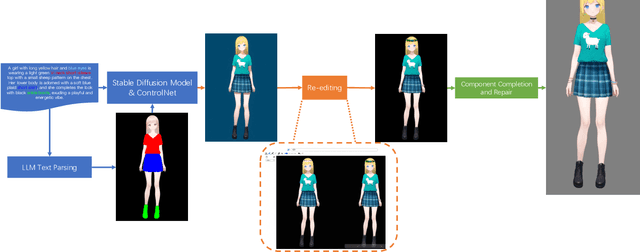
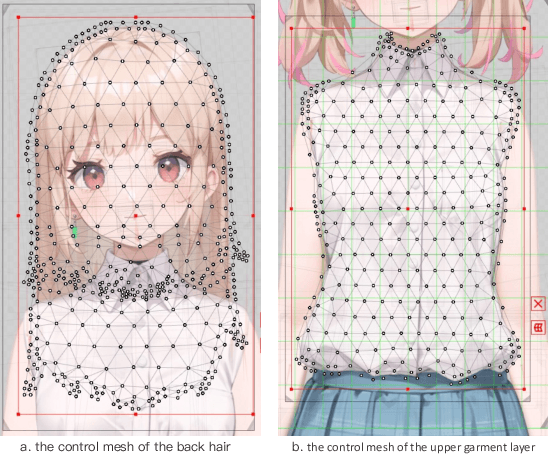
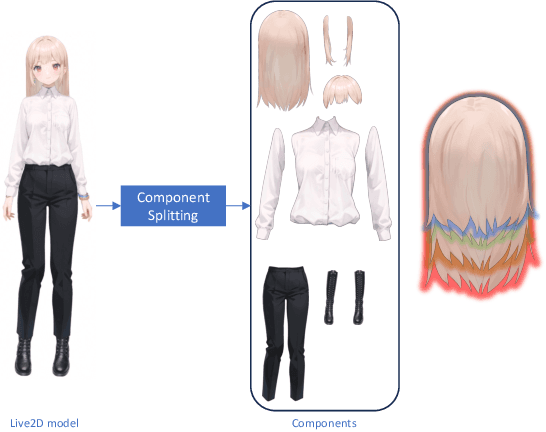

Abstract:The 2D cartoon style is a prominent art form in digital character creation, particularly popular among younger audiences. While advancements in digital human technology have spurred extensive research into photorealistic digital humans and 3D characters, interactive 2D cartoon characters have received comparatively less attention. Unlike 3D counterparts, which require sophisticated construction and resource-intensive rendering, Live2D, a widely-used format for 2D cartoon characters, offers a more efficient alternative, which allows to animate 2D characters in a manner that simulates 3D movement without the necessity of building a complete 3D model. Furthermore, Live2D employs lightweight HTML5 (H5) rendering, improving both accessibility and efficiency. In this technical report, we introduce Textoon, an innovative method for generating diverse 2D cartoon characters in the Live2D format based on text descriptions. The Textoon leverages cutting-edge language and vision models to comprehend textual intentions and generate 2D appearance, capable of creating a wide variety of stunning and interactive 2D characters within one minute. The project homepage is https://human3daigc.github.io/Textoon_webpage/.
Unlocking adaptive digital pathology through dynamic feature learning
Dec 29, 2024



Abstract:Foundation models have revolutionized the paradigm of digital pathology, as they leverage general-purpose features to emulate real-world pathological practices, enabling the quantitative analysis of critical histological patterns and the dissection of cancer-specific signals. However, these static general features constrain the flexibility and pathological relevance in the ever-evolving needs of clinical applications, hindering the broad use of the current models. Here we introduce PathFiT, a dynamic feature learning method that can be effortlessly plugged into various pathology foundation models to unlock their adaptability. Meanwhile, PathFiT performs seamless implementation across diverse pathology applications regardless of downstream specificity. To validate PathFiT, we construct a digital pathology benchmark with over 20 terabytes of Internet and real-world data comprising 28 H\&E-stained tasks and 7 specialized imaging tasks including Masson's Trichrome staining and immunofluorescence images. By applying PathFiT to the representative pathology foundation models, we demonstrate state-of-the-art performance on 34 out of 35 tasks, with significant improvements on 23 tasks and outperforming by 10.20% on specialized imaging tasks. The superior performance and versatility of PathFiT open up new avenues in computational pathology.
Interpretable modulated differentiable STFT and physics-informed balanced spectrum metric for freight train wheelset bearing cross-machine transfer fault diagnosis under speed fluctuations
Jun 17, 2024



Abstract:The service conditions of wheelset bearings has a direct impact on the safe operation of railway heavy haul freight trains as the key components. However, speed fluctuation of the trains and few fault samples are the two main problems that restrict the accuracy of bearing fault diagnosis. Therefore, a cross-machine transfer diagnosis (pyDSN) network coupled with interpretable modulated differentiable short-time Fourier transform (STFT) and physics-informed balanced spectrum quality metric is proposed to learn domain-invariant and discriminative features under time-varying speeds. Firstly, due to insufficiency in extracting extract frequency components of time-varying speed signals using fixed windows, a modulated differentiable STFT (MDSTFT) that is interpretable with STFT-informed theoretical support, is proposed to extract the robust time-frequency spectrum (TFS). During training process, multiple windows with different lengths dynamically change. Also, in addition to the classification metric and domain discrepancy metric, we creatively introduce a third kind of metric, referred to as the physics-informed metric, to enhance transferable TFS. A physics-informed balanced spectrum quality (BSQ) regularization loss is devised to guide an optimization direction for MDSTFT and model. With it, not only can model acquire high-quality TFS, but also a physics-restricted domain adaptation network can be also acquired, making it learn real-world physics knowledge, ultimately diminish the domain discrepancy across different datasets. The experiment is conducted in the scenario of migrating from the laboratory datasets to the freight train dataset, indicating that the hybrid-driven pyDSN outperforms existing methods and has practical value.
HybridHash: Hybrid Convolutional and Self-Attention Deep Hashing for Image Retrieval
May 14, 2024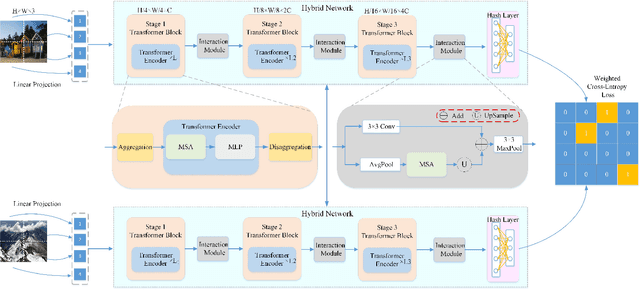
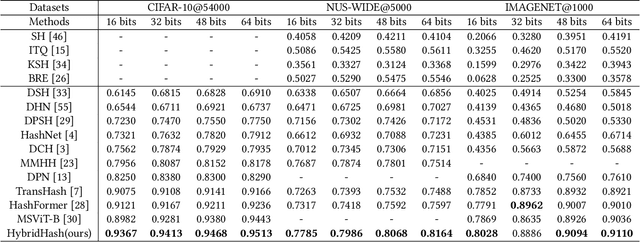
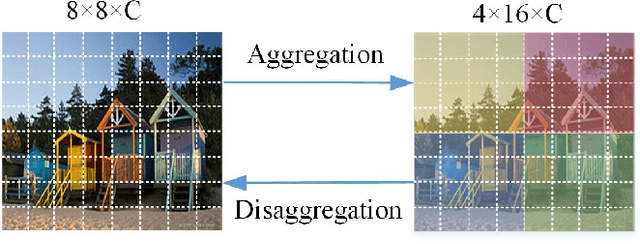
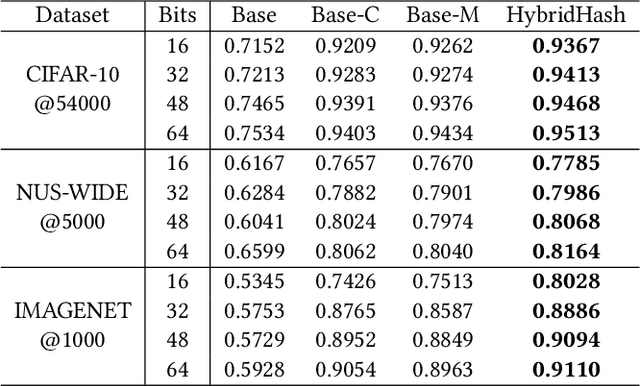
Abstract:Deep image hashing aims to map input images into simple binary hash codes via deep neural networks and thus enable effective large-scale image retrieval. Recently, hybrid networks that combine convolution and Transformer have achieved superior performance on various computer tasks and have attracted extensive attention from researchers. Nevertheless, the potential benefits of such hybrid networks in image retrieval still need to be verified. To this end, we propose a hybrid convolutional and self-attention deep hashing method known as HybridHash. Specifically, we propose a backbone network with stage-wise architecture in which the block aggregation function is introduced to achieve the effect of local self-attention and reduce the computational complexity. The interaction module has been elaborately designed to promote the communication of information between image blocks and to enhance the visual representations. We have conducted comprehensive experiments on three widely used datasets: CIFAR-10, NUS-WIDE and IMAGENET. The experimental results demonstrate that the method proposed in this paper has superior performance with respect to state-of-the-art deep hashing methods. Source code is available https://github.com/shuaichaochao/HybridHash.
Make-A-Character: High Quality Text-to-3D Character Generation within Minutes
Dec 24, 2023Abstract:There is a growing demand for customized and expressive 3D characters with the emergence of AI agents and Metaverse, but creating 3D characters using traditional computer graphics tools is a complex and time-consuming task. To address these challenges, we propose a user-friendly framework named Make-A-Character (Mach) to create lifelike 3D avatars from text descriptions. The framework leverages the power of large language and vision models for textual intention understanding and intermediate image generation, followed by a series of human-oriented visual perception and 3D generation modules. Our system offers an intuitive approach for users to craft controllable, realistic, fully-realized 3D characters that meet their expectations within 2 minutes, while also enabling easy integration with existing CG pipeline for dynamic expressiveness. For more information, please visit the project page at https://human3daigc.github.io/MACH/.
Harmonic enhancement using learnable comb filter for light-weight full-band speech enhancement model
Jun 01, 2023



Abstract:With fewer feature dimensions, filter banks are often used in light-weight full-band speech enhancement models. In order to further enhance the coarse speech in the sub-band domain, it is necessary to apply a post-filtering for harmonic retrieval. The signal processing-based comb filters used in RNNoise and PercepNet have limited performance and may cause speech quality degradation due to inaccurate fundamental frequency estimation. To tackle this problem, we propose a learnable comb filter to enhance harmonics. Based on the sub-band model, we design a DNN-based fundamental frequency estimator to estimate the discrete fundamental frequencies and a comb filter for harmonic enhancement, which are trained via an end-to-end pattern. The experiments show the advantages of our proposed method over PecepNet and DeepFilterNet.
Personalized speech enhancement combining band-split RNN and speaker attentive module
Feb 20, 2023
Abstract:Target speaker information can be utilized in speech enhancement (SE) models to more effectively extract the desired speech. Previous works introduce the speaker embedding into speech enhancement models by means of concatenation or affine transformation. In this paper, we propose a speaker attentive module to calculate the attention scores between the speaker embedding and the intermediate features, which are used to rescale the features. By merging this module in the state-of-the-art SE model, we construct the personalized SE model for ICASSP Signal Processing Grand Challenge: DNS Challenge 5 (2023). Our system achieves a final score of 0.529 on the blind test set of track1 and 0.549 on track2.
 Add to Chrome
Add to Chrome Add to Firefox
Add to Firefox Add to Edge
Add to Edge